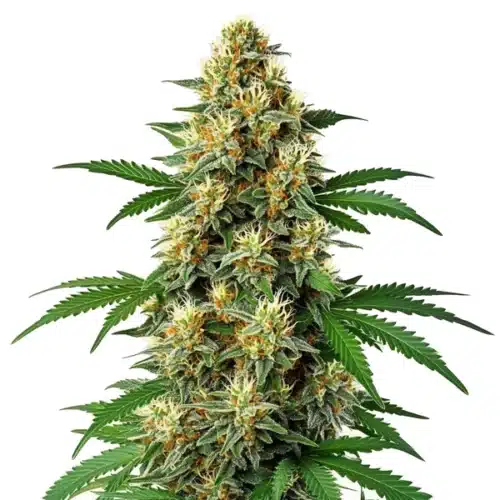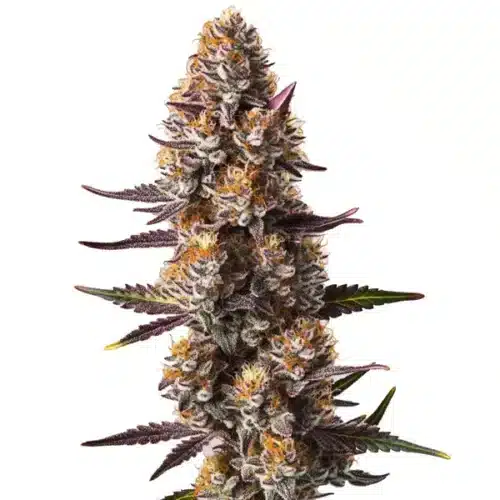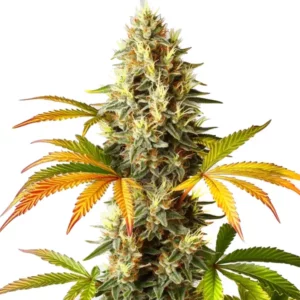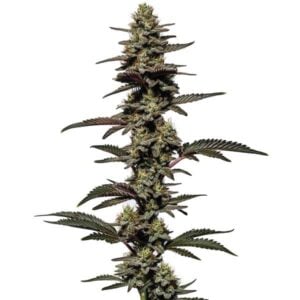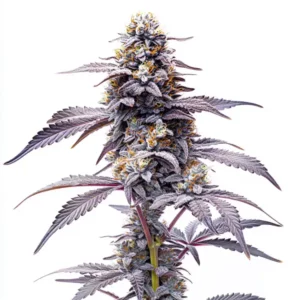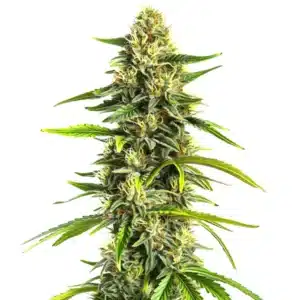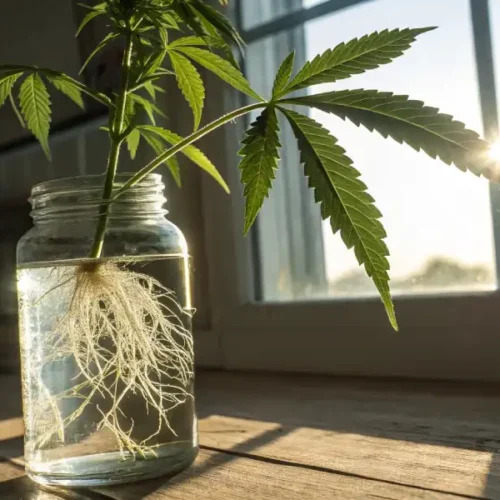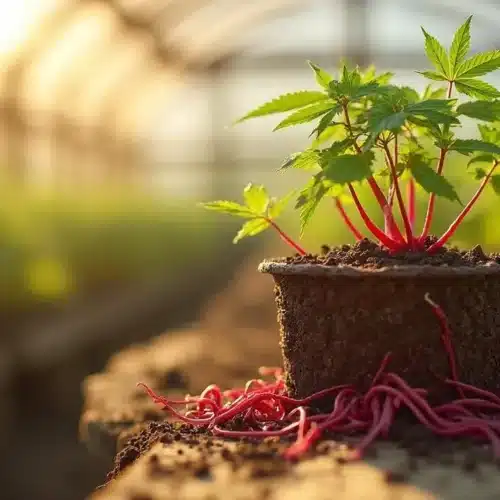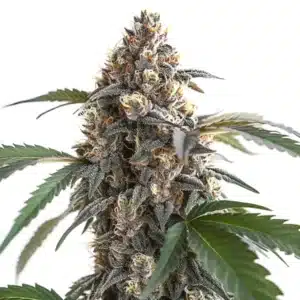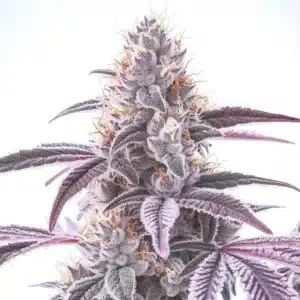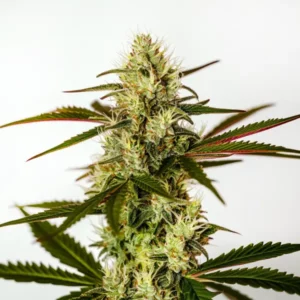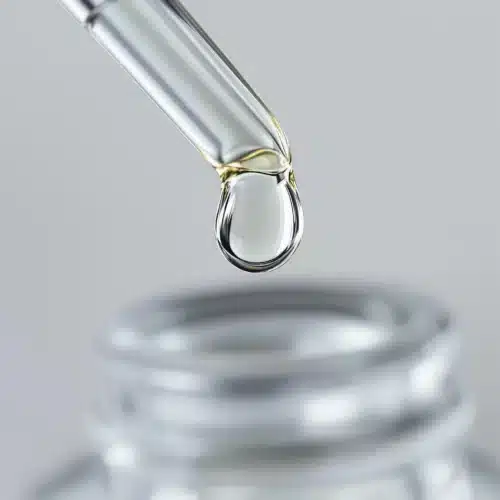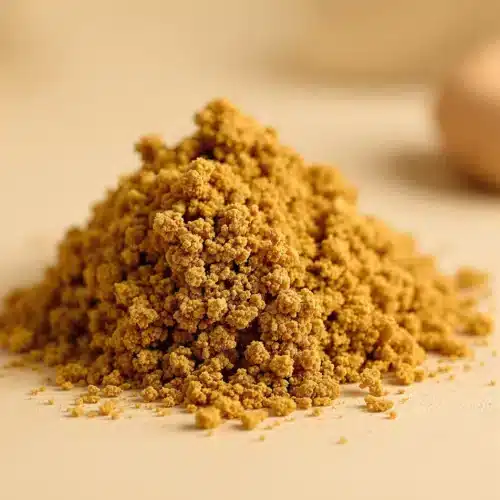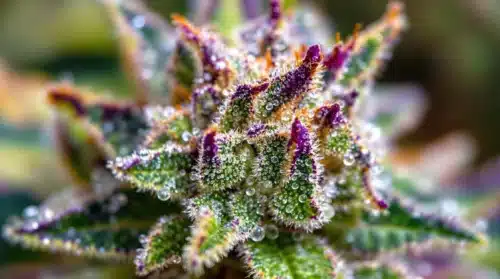For years, farmers have utilized F1 hybrid genetics to cultivate crops that are more consistent, durable, and productive. Today, cannabis cultivators have the ability to grow genuine F1 hybrid cannabis seeds like Green Poison Auto F1 and RudeBoi OG F1, a strain known for its rapid flowering and impressive yields. These strains boast a high level of genetic stability, resulting in increased production of cannabinoids and terpenes, as well as larger yields. Many growers choose F1 seeds for their reliability and quality. Discover all the essential information about F1 hybrids. The best F1 Cannabis Seeds in Blimburn Seeds.
F1 Hybrid Cannabis Seeds are a popular choice among cannabis growers, breeders and enthusiasts because they offer a wide range of unique and desirable characteristics. These hybrid seeds are the result of crossing two different strains of cannabis, each with their own unique genetic traits.
Recommended Strains
Green Poison Auto F1
 THC: 15% - 20%
THC: 15% - 20% Type of seed: Autoflower F1
Type of seed: Autoflower F1 Phenotype: Mostly Hybrid
Phenotype: Mostly Hybrid Day to flower: 8 - 10 weeks
Day to flower: 8 - 10 weeks
Rude Boy OG
 THC: 25% - 28%
THC: 25% - 28% Type of seed: Feminized
Type of seed: Feminized Phenotype: Mostly Indica
Phenotype: Mostly Indica Day to flower: 8 - 10 weeks
Day to flower: 8 - 10 weeks
The result is a seed that contains a combination of traits from both parents, which can lead to new and unique characteristics in the offspring.
One of the main advantages of F1 hybrid cannabis seeds is their vigor. Due to the genetic combination of the two parental strains, the resulting plant has a stronger and more desirable set of characteristics. This means that growers using F1 seeds can expect stronger, healthier plants that are more resistant to disease and pests.
Also, F1 hybrids tend to have more uniform and consistent flowering. This means that all plants will produce flowers at the same time, which can be beneficial for growers who want to harvest their crop all at once. Uniformity can also be important for growers looking to produce a consistent product, as the plants will have a similar appearance and taste.
Another advantage of F1 hybrid cannabis seeds is that they are often more potent than the individual parental strains. Due to the combination of genetic traits, F1 hybrids can have a higher concentration of THC and other cannabinoids than parental strains. This means that marijuana enthusiasts can expect a more intense and longer-lasting experience with an F1 hybrid than with a parental strain.
What Are F1 Hybrid Cannabis Seeds?
F1 cannabis seeds are simply the first-generation offspring of parental strains. Hybrid vigor is a term often used when discussing cannabis seeds, along with the question: what are F1 cannabis seeds? Learn more about the benefits and characteristics of F1 seeds and F1 hybrid cannabis seeds.
If the parental plant strains are quite different – indica and sativa, for instance – then the seeds would be called F1 hybrid cannabis seeds. These seeds may exhibit vigorous growth and display “hybrid vigor,” resulting in faster-than-usual growth. This extra growth vitality is observed when different cannabis genetics are hybridized to create an F1 cannabis cross.
Advantages – F1 Hybrid Cannabis Seeds
F1 hybrid cannabis seeds are the result of crossbreeding two heavily inbred parent lines, which leads to cannabis strains that are more resistant to diseases, have higher yields, and are more uniform in growth compared to typical cannabis strains.
The term “F1” refers to the “filial 1” generation, which is the first offspring produced by breeding two inbred lines. Unlike traditional breeding methods, inbreeding creates offspring with remarkable consistency and desirable traits. Familiarity with the following three terms is essential to grasp the concept of F1 cannabis hybrids.
Promos & Deals
The Heterozygosity in F1 Hybrid Cannabis Seeds
Like humans, cannabis plants inherit a pair of chromosomes from their parents that contain numerous genes, which dictate their biological traits. Each gene can have different forms or expressions, known as alleles. Heterozygosity occurs when a specific gene presents two different alleles.
For instance, when a cannabis breeder crosses a plant exhibiting purple color with one showing green color, the heterozygous offspring will inherit two different alleles that code for color, resulting in heterozygous plants with both green (higher chlorophyll expression) and purple (higher anthocyanin expression) alleles.
When these heterozygous plants are crossed with another plant, some specimens will inherit the green allele, while others will receive the purple allele, leading to an unstable generation of plants.
While environmental factors also influence plant color, this simplified example outlines how regular crossbreeding works. Grasping heterozygosity and other key terms is essential for fully appreciating the concept of F1 hybrid cannabis seeds.
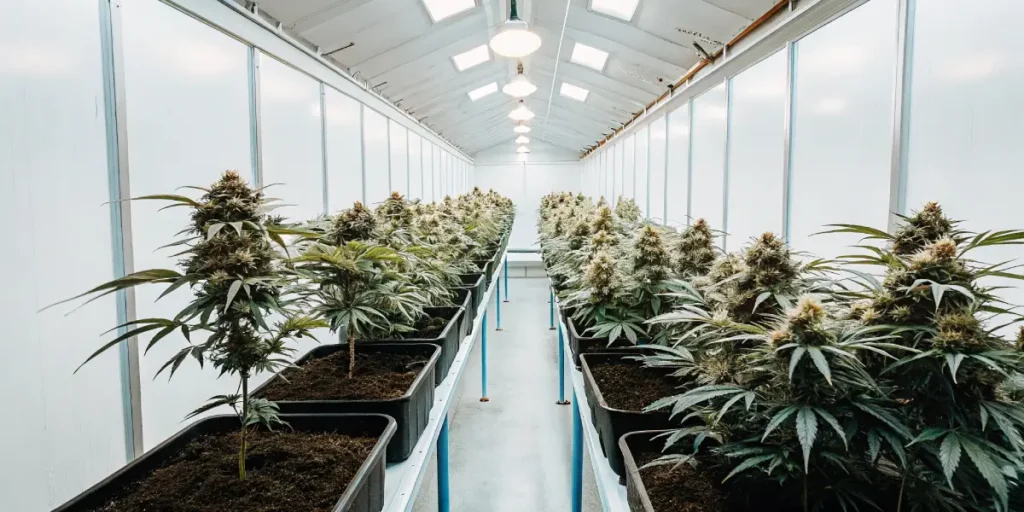
The Homozygosity in F1 Hybrid Cannabis Strains
Homozygosity in F1 hybrid cannabis seeds is the inheritance of two alleles that code for the same trait, resulting in a more stable and uniform plant. For instance, if a breeder desires a plant with a purple hue, they will select parents with the same alleles that code for a high concentration of anthocyanins.
This breeding process ensures that the offspring consistently display the desired trait, resulting in a more predictable crop. Producing homozygous plants enables breeders and growers to achieve more consistent and desirable results, making it a preferred choice for many cultivators.
The Vigor – F1 Cannabis Seeds
Inbreeding produces highly consistent and stable genetics, but it can also lead to inbreeding depression, resulting in reduced crop vitality, performance, and resistance. On the other hand, crossing plants from different inbred lines can revitalize genetics within the progeny, leading to hybrid vigour or heterosis.
This phenomenon refers to the increase in biomass, disease resistance, and productivity observed in F1 hybrids. Learn about the benefits and drawbacks of inbreeding and how hybrid vigour can improve the genetics of your cannabis crop. Boost your plant’s vitality, performance, and resistance with F1 seeds and hybrids.
F1 Breeding Hybrids
First generation (F1) hybrids are inbred to allow recessive genes to express the desired parental traits. Unfortunately, many breeders stop at the first cross and fail to produce an F2 generation by crossing or self-pollinating F1 offspring. This is a missed opportunity to realize the full genetic potential of their strain. However, inbreeding domestic hybrid strains can result in great diversity and recessive recombination.
By skipping the F1 generation and going directly to F2 hybrids, breeders can save a year and increase the likelihood of expressing recessive parental traits. From the F2 hybrid generation, selections can be made for parents to create new true-breeding strains.
In some cases, F2 hybrids may even exhibit more extreme characteristics than either of the parental strains. For example, selfing an F1 hybrid of high-THC and low-THC parents may yield F2 hybrids of both high and low THC phenotypes, intermediate F1 phenotypes, and extra-high or extra-low THC phenotypes.
F1 hybrids are not true-breeding and must be reproduced from the original parental strains due to gene recombination. Breeders aim to produce enough hybrid seeds to last for several successive years of cultivation. Undesirable hybrid seeds are destroyed while desirable ones are stored for later use.
If hybrids are to be reproduced, a clone is saved from each parental plant to preserve original parental genes. Back-crossing is another technique used to reinforce parental characteristics.
A cross is made between one of the F1 or subsequent offspring and either of the parents expressing the desired trait. This provides a chance for recombination and possible expression of the selected parental trait. Although it’s a valuable way of producing new strains, back-crossing can be difficult because Cannabis is an annual.
To save parental stock for back-crossing the following year, breeders use indoor lighting or greenhouses to protect breeding stock from winter weather. In tropical areas, plants may live outside all year. A successful breeder saves many seeds from the original P1 group that produced the valuable characteristic so that other P1 plants exhibiting the characteristic can be grown and selected for back-crossing at a later time.
How to produce F1 cannabis seeds?
Improvement is simply the recombination of existing genes into new genotypes. By using hybridization, breeders can select desirable characteristics from different strains and create new strains with unique traits. The possibilities of recombination are nearly limitless, and the F2 generation is a great source of variation and recessive expression.
Producing true-breeding strains involves inbreeding and hybridization. Inbreeding limits the diversity of the gene pools in the two strains to be hybridized, resulting in F1 hybrids that are less variable.
Further independent selection and inbreeding of the best plants for several generations will establish two strains that are true-breeding for all the originally selected traits. Successive inbreeding may result in steady decline in the vigor of the strain, but this can be restored by interbreeding the separately selected strains.
By following these steps, breeders can produce hybrid strains that breed true for selected traits.
Rude Boy OG F1
Rude Boy OG F1 a mostly indica strain resulting from a cross between Rude Boy OG and OG Kush. This F1 hybrid strain is the first generation hybrid resulting from crossing two pure strains of cannabis, and it’s known for its stability and uniformity, making it a popular choice for growers. The Mostly Hybrid strain is characterized by its Earthy, Citrus, Pine flavor and a strong body high.
It has a Medium THC level of 19% – 23%, making it a great choice for those who want to enjoy the effects of both indica and sativa without getting too overwhelmed. The F1 hybrid strains are capable of producing a strain of different effects, flavors, and aromas. Unlike their F2 and F3 counterparts, they are typically more stable and uniform, making them a popular choice for growers.
Get free Rude Boi OG F1 seeds in the Bogo of our Blimburn Seeds store, where we also offer discounts and special promotions. Now, if you wonder what kind of diseases you can treat with Rude Boi OG F1, we tell you that old age and stress can be treated with this genetic.
The above, because in this strain of weed the terpenes Caryophyllene and Limonene predominate. The first of the terpenes helps to reduce levels of anxiety and is present in the aromas, spices, pepper and oregano that Rude Boi OG F1 gives off.
You must be clear that if you grow Rude Boi OG F1 you are going to get plants with large yields outdoors, since it delivers between 28 – 42 oz/plant, therefore it is always recommended to use stakes and supports that support the weight of the arms. When you apply pruning to this genetics, it will multiply in terms of the number of arms and therefore the production will increase. For indoor gardeners, yields can be between 1.97 – 2.62 oz/ft2.
Wedding Crasher F1
The resulting mostly sativa strain from crossing Wedding Cake and Purple Punch is likely to have a sweet, peach, fruity flavor profile. The high is characterized by a strong body high, perfect for those looking to enjoy the effects of both indica and sativa strains in a balanced experience.
Wedding Crasher F1 have a THC level of 19%-22% is perfect for people with high resistance to THC. Wedding Crasher best F1 strains contains a strain of terpenes, including Limonene, Caryophyllene, Linalool, Geraniol, Myrcene, and Humulene. These terpenes are known for their properties of stress relief, anxiety reduction, pain management, and creativity.
Wedding Crasher F1 strain has a short flowering time of just 9-10 weeks, making it an ideal choice for growers who want to see quick results. Indoor growers can achieve up to 1.31 – 1.64 oz/ft2 , while outdoor growers can yield up to 17 – 21 oz/plant in the right climate and with skill.
Wedding Crasher F1 Feminized plants require low humidity levels to grow and produce healthy yields. During the vegetative phase, maintain relative humidity (RH) levels between 55% and 60%. As the plants transition to the flowering phase, reduce the RH to around 40%. By harvest time, you can further reduce the RH to 30%.
If you live in humid areas with cold or warm temperatures, it is recommended to grow Wedding Crasher F1 indoors or in greenhouses. Indoor cultivation allows for greater control over the growing environment, including temperature, humidity, and air circulation. Greenhouse cultivation provides a balance between indoor and outdoor cultivation, allowing natural light to enter while still providing some level of environmental control.
In humid areas, it’s important to maintain good air circulation to prevent the growth of mold and mildew, which can damage your crop and lower your yield. Using fans to improve air circulation can also help regulate temperature and humidity levels, creating a more optimal growing environment.
In addition to using fans, it’s also advisable to use extractors to remove dirty and contaminated air from the growing area and allow fresh air to enter. This can help prevent the buildup of excess humidity and carbon dioxide, which can also contribute to the growth of mold and mildew.
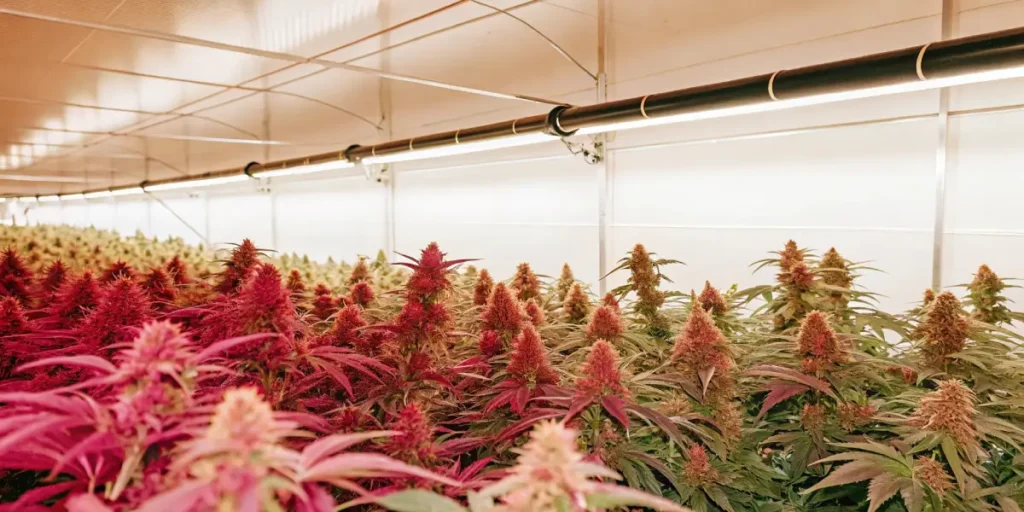
Sour Mac F1
Sour MAC F1 is a great choice. This medium to tall plant has a slender stature and produces elongated, airy buds that are different from Indicas. To get the most out of your Sour Mac plants, it’s important to give them plenty of room to grow. You can use SCROG or LST cultivation techniques to stimulate secondary ramification and small low branch development. These methods will help your plants reach their full potential.
Whether you’re a beginner or an experienced grower, Sour MAC F1 is easy to cultivate. It produces a resinous harvest with a yield of up to 1.31-1.63 oz/ft2 in just 8–10 weeks of indoor flowering. Try it out today and experience the benefits of this high-quality strain.
Sour MAC F1 is a Sativa-dominant hybrid that boasts a powerful lemony aroma from the very beginning of the flowering stage. Due to its intense fragrance, it is recommended to use a carbon filter. This strain’s scent is composed of a sour and sweet citric base, accompanied by earthy, woody, and spicy herbal notes with a touch of petrol.
With a THC level of 20%- 25%, Sour MAC F1 is an excellent choice for those seeking a cerebral and euphoric high that promotes creativity and keeps you active.
To maximize the growth of Sour MAC F1 plants, it’s best to start cultivating them indoors and then move them outside or into a greenhouse during the spring. By doing so, you can ensure that they begin their flowering stage under the best possible conditions, which will help prevent any losses that could arise during cultivation.
Given that this strain requires several weeks of flowering, this approach will enable you to make the most of your Sour MAC F1 plants.
FAQs
What are F1 hybrid cannabis seeds and why are they popular among growers?
F1 hybrid cannabis seeds are first-generation seeds created by crossing two genetically stable parent strains. They are popular among growers because they produce plants with hybrid vigor—offering stronger growth, higher resistance to diseases and pests, and more uniform flowering. These seeds also tend to yield higher cannabinoid and terpene levels, providing better potency and flavor profiles.
What are the advantages of growing F1 hybrid cannabis seeds?
Growing F1 hybrid cannabis seeds offers several advantages: improved vigor, uniform plant structure, faster growth, and increased resistance to diseases. They also deliver more consistent yields with predictable cannabinoid and terpene profiles, making them an excellent choice for both beginners and experienced growers aiming for high-quality crops.
Are F1 hybrid cannabis seeds suitable for beginners?
Yes, F1 hybrid cannabis seeds are ideal for beginners. Their genetic stability and robust growth make them more forgiving during cultivation. Many strains, such as Green Poison Auto F1 and Rude Boi OG F1, offer uniform flowering times and high resistance to common issues, helping novice growers achieve successful harvests with less risk.

